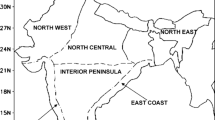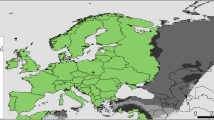Abstract
Characteristics and changes in minimum and maximum air temperatures and associated climate indices are analysed for Zagreb city (Croatia). Daily data from the period 1960–2019 at four meteorological stations (urban, suburb, airport and mountain) are used. Generally, changes in extreme temperatures showed to be the least expressed at the mountain site compared to other city stations. An increase (decrease) in the frequency of warm (cold) extremes is obtained using both stationary (applied to non-overlapping 30-year periods) and non-stationary (applied to the whole period of the analysis) generalized extreme value distribution. Likelihood ratio test revealed that inclusion of linearly time-dependent location parameter significantly improves the performance of the model, especially for maximum air temperature. The effect of a period used as a reference for the percentile-based indices estimation is analysed using three different periods: standard climatological period 1961–1990, recent climatological period 1981–2010 and the whole period of the analysis 1960–2019. Regardless of the base period used, generally significant increase (decrease) in warm (cold) indices is detected for both summer and winter season. Still, increase (decrease) in warm (cold) indices is stronger when period 1961–1990 (1981–2010) is used as a reference. The effect of different period used as a reference is more expressed for summer season. Summer trend rates showed to be stronger compared to the winter ones, especially for the right side of the distributions (warm indices). This is due to a more pronounced increasing trend in the latest 30-year period compared to the earlier period.
The obtained results imply potential increase (decrease) in risk associated with warm (cold) events which showed to be more expressed for warm summer extremes.





Similar content being viewed by others
Data availability
The climate data used in this study are the property of the Croatian Meteorological and Hydrological Service. Terms of use, data availability and contact can be found at: https://klima.hr/razno/katalog_i_cjenikDHMZ.pdf (accessed on 28 May 2021).
Code availability
Not applicable.
References
Alexander LV, Zhang X, Peterson TC, et al (2006) Global observed changes in daily climate extremes of temperature and precipitation. J Geophys Res Atmospheres 111: https://doi.org/10.1029/2005JD006290
Arnfield AJ (2003) Two decades of urban climate research: a review of turbulence, exchanges of energy and water, and the urban heat island. Int J Climatol 23:1–26. https://doi.org/10.1002/joc.859
Bartholy J, Pongrácz R (2007) Regional analysis of extreme temperature and precipitation indices for the Carpathian Basin from 1946 to 2001. Glob Planet Change 57:83–95. https://doi.org/10.1016/j.gloplacha.2006.11.002
Bronaugh D for the Pacific Climate Impacts Consortium (2020). climdex.pcic: PCIC implementation of climdex routines. R package version 1.1–11. https://CRAN.R-project.org/package=climdex.pcic
Brugnara Y, Auchmann R, Brönnimann S et al (2016) Trends of mean and extreme temperature indices since 1874 at low-elevation sites in the southern Alps. J Geophys Res Atmospheres 121:3304–3325. https://doi.org/10.1002/2015JD024582
Cindrić K, Pasarić Z (2018) Modelling dry spells by extreme value distribution with Bayesian inference. Pure Appl Geophys 175:3891–3908. https://doi.org/10.1007/s00024-018-2007-6
Coles S (2001) An Introduction to Statistical Modeling of Extreme Values. Springer-Verlag, London
Croce P, Formichi P, Landi F (2019) Climate change: impacts on climatic actions and structural reliability. Appl Sci 9:5416. https://doi.org/10.3390/app9245416
Cvitan L, Sokol Jurković R (2016) Secular trends in monthly heating and cooling demands in Croatia. Theor Appl Climatol 125:565–581. https://doi.org/10.1007/s00704-015-1534-7
Della-Marta PM, Luterbacher J, von Weissenfluh H et al (2007) Summer heat waves over western Europe 1880–2003, their relationship to large-scale forcings and predictability. Clim Dyn 29:251–275. https://doi.org/10.1007/s00382-007-0233-1
Gilleland E, Katz RW (2016) extRemes 2.0: an extreme value analysis package in R. J Stat Softw 72:1–39. https://doi.org/10.18637/jss.v072.i08
Giorgi F (2006) Climate change hot-spots. Geophys Res Lett 33:. https://doi.org/10.1029/2006GL025734
Guijarro JA (2019) climatol: Climate Tools (Series Homogenization and Derived Products). R package version 3.1.2. https://CRAN.R-project.org/package=climatol
Helsel DR, Hirsch RM (2002) Statistical methods in water resources. U.S. Geological Survey, Reston, VA
Jungo P, Beniston M (2001) Changes in the anomalies of extreme temperature anomalies in the 20th century at Swiss climatological stations located at different latitudes and altitudes. Theor Appl Climatol 69:1–12. https://doi.org/10.1007/s007040170031
Juras J (1985) Some characteristics of climatic change at Zagreb during the last thirty years. (In Croatian). Geofizika 2:93–102
Jurčec V (1985) Local wind regime in the Zagreb area and mountain circulation. (In Croatian). Geofizika 2:121–140
Katz RW, Brown BG (1992) Extreme events in a changing climate: variability is more important than averages. Clim Change 21:289–302. https://doi.org/10.1007/BF00139728
Kioutsioukis I, Melas D, Zerefos C (2010) Statistical assessment of changes in climate extremes over Greece (1955–2002). Int J Climatol 30:1723–1737. https://doi.org/10.1002/joc.2030
Klein Tank AMG, Können GP (2003) Trends in indices of daily temperature and precipitation extremes in Europe, 1946–99. J Clim 16:3665–3680. https://doi.org/10.1175/1520-0442(2003)016%3c3665:TIIODT%3e2.0.CO;2
Klein Tank AMG, Wijngaard JB, Können GP et al (2002) Daily dataset of 20th-century surface air temperature and precipitation series for the European Climate Assessment. Int J Climatol 22:1441–1453. https://doi.org/10.1002/joc.773
Klein Tank AMG, Zwiers FW, Zhang X (2009) WCDMP, 72. Guidelines on Analysis of extremes in a changing climate in support of informed decisions for adaptation. WMO, Geneva
Lisac I (1984) The wind in Zagreb (A contribution to the knowledge of climate of the city of Zagreb, II). (In Croatian). Geofizika 1:47–134
Lončar E (1991) Statistička analiza inverzija i visine sloja miješanja na području Zagreba. Hrvat Meteorološki Časopis 26:87–98
Makjanić B, Penzar B, Penzar I (1977) Prilog poznavanju klime grada Zagreba, I. (In Croatian). Sveučilište u Zagrebu, Zagreb
Matzarakis A, Hämmerle M, Koch E, Rudel E (2012) The climate tourism potential of Alpine destinations using the example of Sonnblick, Rauris and Salzburg. Theor Appl Climatol 110:645–658. https://doi.org/10.1007/s00704-012-0686-y
Moberg A, Jones PD, Lister D, et al (2006) Indices for daily temperature and precipitation extremes in Europe analyzed for the period 1901–2000. J Geophys Res Atmospheres 111:. https://doi.org/10.1029/2006JD007103
Nemec J, Gruber C, Chimani B, Auer I (2013) Trends in extreme temperature indices in Austria based on a new homogenised dataset. Int J Climatol 33:1538–1550. https://doi.org/10.1002/joc.3532
Nimac I, PerčecTadić M (2017) Complete and homogeneous monthly air temperature series for the construction of 1981–2010 climatological normals in Croatia. Geofizika 34:225–249. https://doi.org/10.15233/gfz.2017.34.13
Oke TR, Mills G, Christen A, Voogt JA (2017) Urban Climates. Cambridge University Press, Cambridge
Omazić B, Prtenjak MT, Prša I et al (2020) Climate change impacts on viticulture in Croatia: viticultural zoning and future potential. Int J Climatol 40:5634–5655. https://doi.org/10.1002/joc.6541
Pandžić K, Likso T (2010) Homogeneity of average annual air temperature time series for Croatia. Int J Climatol 30:1215–1225. https://doi.org/10.1002/joc.1922
Penzar B (1976) The climates of Zagreb, Osijek, Rijeka and Split. Zagreb, Geogr Papers
Penzar B, Penzar I, Juras J, Marki A (1992) Brief review of the climatic fluctuations recorded in Zagreb between 1862 and 1990. Geofizika 9:57–67
Rangwala I, Miller JR (2012) Climate change in mountains: a review of elevation-dependent warming and its possible causes. Clim Change 114:527–547. https://doi.org/10.1007/s10584-012-0419-3
Santo FE, de Lima MIP, Ramos AM, Trigo RM (2014) Trends in seasonal surface air temperature in mainland Portugal, since 1941. Int J Climatol 34:1814–1837. https://doi.org/10.1002/joc.3803
Schär C, Vidale PL, Lüthi D et al (2004) The role of increasing temperature variability in European summer heatwaves. Nature 427:332–336. https://doi.org/10.1038/nature02300
Scorzini AR, Leopardi M (2019) Precipitation and temperature trends over central Italy (Abruzzo Region): 1951–2012. Theor Appl Climatol 135:959–977. https://doi.org/10.1007/s00704-018-2427-3
Sen PK (1968) Estimates of the regression coefficient based on Kendall’s tau. J Am Stat Assoc 63:1379–1389. https://doi.org/10.1080/01621459.1968.10480934
Spinoni J, Lakatos M, Szentimrey T, et al (2015) Heat and cold waves trends in the Carpathian Region from 1961 to 2010. Int J Climatol 35:. https://doi.org/10.1002/joc.4279
Sulikowska A, Wypych A (2020) Summer temperature extremes in Europe: how does the definition affect the results? Theor Appl Climatol 141:19–30. https://doi.org/10.1007/s00704-020-03166-8
Tramblay Y, Koutroulis A, Samaniego L et al (2020) Challenges for drought assessment in the Mediterranean region under future climate scenarios. Earth Sci Rev 210:103348. https://doi.org/10.1016/j.earscirev.2020.103348
Unkašević M, Tošić I (2009) Changes in extreme daily winter and summer temperatures in Belgrade. Theor Appl Climatol 95:27–38. https://doi.org/10.1007/s00704-007-0364-7
Unkašević M, Tošić I (2013) Trends in temperature indices over Serbia: relationships to large-scale circulation patterns. Int J Climatol 33:3152–3161. https://doi.org/10.1002/joc.3652
Unkašević M, Vujović D, Tošić I (2005) Trends in extreme summer temperatures at Belgrade. Theor Appl Climatol 82:199–205. https://doi.org/10.1007/s00704-005-0131-6
Volarić B (1999) Classic fohn theory and its geographic distribution. (In Croatian). Hrvat Meteorološki Časopis 33/34:53–62
Wilks DS (2006) Statistical Methods in the Atmospheric Sciences. Second edition, Academic Press
WMO (2004) WCDMP, 54. Report of the CCI/CLIVAR Expert Team on Climate Change Detection, Monitoring and Indices (ETCCDMI). WMO, Geneva
WMO (2017) WMO Guidelines on the Calculation of Climate Normals, 2017th edn. WMO, Geneva
Yosef Y, Aguilar E, Alpert P (2020) Is it possible to fit extreme climate change indices together seamlessly in the era of accelerated warming? Int J Climatol 1–12. https://doi.org/10.1002/joc.6740
Zaninović K, Gajić-Čapka M, Perčec Tadić M, et al (2008) Klimatski atlas Hrvatske, Climate atlas of Croatia: 1961–1990:1971–2000
Zaninović K, Matzarakis A (2013) Impact of heat waves on mortality in Croatia. Int J Biometeorol 58:. https://doi.org/10.1007/s00484-013-0706-3
Zhang X, Hegerl G, Zwiers FW, Kenyon J (2005) Avoiding inhomogeneity in percentile-based indices of temperature extremes. J Clim 18:1641–1651. https://doi.org/10.1175/JCLI3366.1
Acknowledgements
The authors thank the two anonymous reviewers for their constructive comments and suggestions which improved the paper.
Funding
This work has been fully supported by Croatian Science Foundation under the project UIP-2017–05-6396 (CroClimGoGreen).
Author information
Authors and Affiliations
Contributions
I. Nimac and I. Herceg-Bulić designed the study. All authors contributed to the analysis and interpretation of the results and writing the manuscript. All authors have read and approved the final manuscript.
Corresponding author
Ethics declarations
Ethics approval and consent to participate
Not applicable.
Consent for publication
Not applicable.
Conflict of interest
The authors declare that they have no conflict of interest.
Additional information
Publisher’s note
Springer Nature remains neutral with regard to jurisdictional claims in published maps and institutional affiliations.
Rights and permissions
About this article
Cite this article
Nimac, I., Herceg-Bulić, I., Cindrić Kalin, K. et al. Changes in extreme air temperatures in the mid-sized European city situated on southern base of a mountain (Zagreb, Croatia). Theor Appl Climatol 146, 429–441 (2021). https://doi.org/10.1007/s00704-021-03689-8
Received:
Accepted:
Published:
Issue Date:
DOI: https://doi.org/10.1007/s00704-021-03689-8




